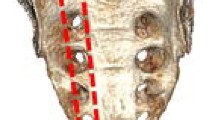Abstract
Purpose
The aim of this study was to compare the outcomes of ilio-sacral (IS) screw fixation with and without the use of bowel preparation, in terms of obtaining adequate visualisation, malpositioning of screw requiring revision surgery and neurovascular injury.
Methods
A retrospective case control study was performed. We reviewed 74 consecutive cases of IS screw fixation performed at our institution within the last 5 years. We included all patients who had undergone percutaneous IS screw fixation. Two groups, one consisting of patients who underwent bowel preparation prior to surgery (Group 1) and one consisting of patients who had no bowel preparation (Group 2), were compared in terms of the above outcomes. There were 37 patients in each group. The mean age in Group 1 was 41 years (17–63) and in Group 2 was 47 years (12–89).
Results
In Group 1 there were two procedures abandoned due to poor visualisation. In Group 2 there were no cases abandoned for poor visualisation. There were two nerve injuries in Group 1 and no nerve injuries in Group 2. Revision surgery was performed in four patients in Group 1—for malposition, persistent buttock pain, sciatic nerve palsy and inadequate fixation while one revision performed in Group 2 for persistent buttock pain.
Conclusion
Based on these results, we conclude that bowel preparation is not necessary to obtain adequate visualisation for safe and accurate percutaneous IS screw insertion. In fact, in Group 1 two procedures were abandoned and there was higher incidence of complications. Therefore, it would appear that this treatment arm should be abandoned all together. Further studies to prove it conclusively and explain the reasons are required.



Similar content being viewed by others
References
Routt ML Jr, Nork SE, Mills WJ. Percutaneous fixation of pelvic ring disruptions. Clin Orthop Relat Res. 2000;375:15–29.
Matta JM, Saucedo T. Internal fixation of pelvic ring fractures. Clin Orthop Relat Res. 1989;242:83–97.
Keating JF, Werier J, Blachut P, Broekhuyse H, Meek RN, O’Brien PJ. Early fixation of the vertically unstable pelvis: the role of ilio-sacral screw fixation of the posterior lesion. J Orthop Trauma. 1999;13(2):107–13.
Bishop JA, Routt MLC Jr. Osseous fixation pathways in pelvic and acetabular fracture surgery: osteology, radiology, and clinical applications. J Trauma Acute Care Surg. 2012;72(6):1502–9.
Eastman JG, Routt MLC Jr. Correlating preoperative imaging with intraoperative fluoroscopy in iliosacral screw placement. J Orthop Traumatol. 2015;16:309–16.
Ozmeric A, Yucens M, Gultaç E, Açar HI, Aydogan NH, Gül D, Alemdaroglu KB. Are two different projections of the inlet view necessary for the percutaneous placement of ilio-sacral screws? Bone Joint J. 2015;97-B(5):705–10.
Zwingmanna J, Sudkampa NP, Konig B, Culemann U, Pohlemann T, Aghayev E. Intra- and postoperative complications of navigated and conventional techniques in percutaneous ilio-sacral screw fixation after pelvic fractures: results from the German Pelvic Trauma Registry. Injury. 2013;44(12):1765–72.
Khurana A, Guha AR, Mohanty K, Ahuja S. Percutaneous fusion of the sacroiliac joint with hollow modular anchorage screws. Clinical and radiological outcome. J Bone Joint Surg Br. 2009;91(5):627–31.
Naudé PH, Roche S, Nortje M, Maqungo S. The safety and efficacy of percutaneous sacroiliac joint screw fixation. SA Orthop J. 2014;13(4):26–9.
Gras Florian, Marintschev Ivan, Wilharm Arne, Klos Kajetan. 2D-fluoroscopic navigated percutaneous screw fixation of pelvic ring injuries—a case series. BMC Musculoskelet Disord. 2010;11:153.
Holte K, Nielsen KG, Madsen JL, et al. Physiologic effects of bowel preparation. Dis Colon Rectum. 2004;47:1397–402.
Shrestha D, Dhoju D, Shrestha R, Sharma V. Percutaneous ilio-sacral screw fixation in supine position under fluoroscopy guidance. Khatmandu Univ Med J. 2015;13(49):56–60.
Matta JM, Tornetta P. Internal fixation of unstable pelvic ring injuries. Clin Orthop Relat Res. 1996;329:129–40.
Cruz HA, de Angelis GP. Sacroiliac secure corridor: analysis for safe insertion of iliosacral screws. Rev Bras Ortop. 2013;48(4):348–56.
Zwingmann J, Hauschild O, Sudkamp NP, Schmal H. Malposition and revision rates of different imaging modalities for percutaneous iliosacral screw fixation following pelvic fractures: a systematic review and meta-analysis. Arch Orthop Trauma Surg. 2013;133(9):1257–65.
Hinsche AF, Giannoudis PV, Smith RM. Fluoroscopy based multi-planar image guidance for insertion of sacroiliac screws. Clin Orthop Relat Res. 2002;395:135–44.
Van den Bosch EW, van Zwienen CM, van Vugt AB. Fluoroscopic positioning of sacro-iliac screws in 88 patients. J Trauma. 2002;53(1):44–8.
Tonetti J, Carrat L, Blendea S, Merloz P. Clinical results of percutaneous pelvic surgery. Computer assisted surgery using ultrasound compared to standard fluoroscopy. Comput Aided Surg. 2001;6(4):204–11.
Zwingmann J, Südkamp NP, König B, Culemann U, Pohlemann T, Aghayev E, Schmal H. Intra- and postoperative complications of navigated and conventional techniques in percutaneous ilio-sacral screw fixation after pelvic fractures: results from the German Pelvic Trauma Registry. Inj Int J Care Inj. 2013;44:1765–72.
Tonetti J, Van Overschelde J, Sadok B, Vouaillat H, Eid A. Percutaneous ilio-sacral screw insertion. Fluoroscopic techniques. Orthop Traumatol Surg Res. 2013;99(8):965–72.
Khurana A, Guha AR, Mohanty K, Ahuja S. Percutaneous fusion of the sacroiliac joint with hollow modular anchorage screws. Clinical and radiological outcome. J Bone Joint Surg (Br). 2009;91-B(5):627–31.
Heher EC, Thier SO, Rennke H, Humphreys BD. Adverse renal and metabolic effects associated with oral sodium phosphate bowel preparation. Clin J Am Soc Nephrol. 2008;3:1494–503.
Ladas SD, Karamanolis G, Ben-Soussan E. Colonic gas explosion during therapeutic colonoscopy with electrocautery. World J Gastroenterol: WJG. 2007;13(40):5295–8.
Author information
Authors and Affiliations
Corresponding author
Ethics declarations
Conflict of interest
All authors declare that they have no conflict of interest.
Rights and permissions
About this article
Cite this article
Raza, H., Bowe, A., Davarinos, N. et al. Bowel preparation prior to percutaneous ilio-sacral screw insertion: is it necessary?. Eur J Trauma Emerg Surg 44, 211–214 (2018). https://doi.org/10.1007/s00068-016-0704-3
Received:
Accepted:
Published:
Issue Date:
DOI: https://doi.org/10.1007/s00068-016-0704-3




